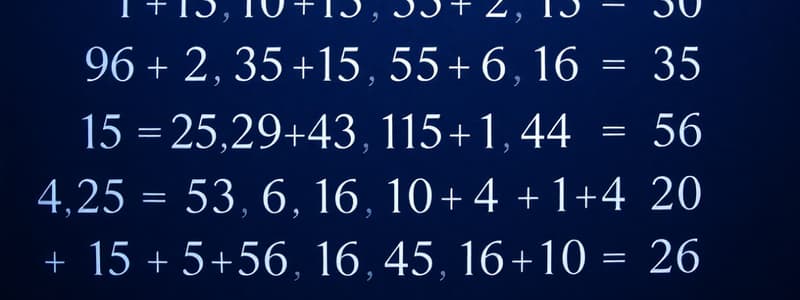Podcast
Questions and Answers
In the bord and pillar mining layout described, what is the center-to-center distance between the pillars given the gallery/cross-cut width?
In the bord and pillar mining layout described, what is the center-to-center distance between the pillars given the gallery/cross-cut width?
- 5 m
- 40 m
- 35 m (correct)
- 150 m
Given the coal seam depth and the angle of draw, how would you initially estimate the area of influence for surface subsidence?
Given the coal seam depth and the angle of draw, how would you initially estimate the area of influence for surface subsidence?
- Multiply the depth by the tangent of the angle of draw. (correct)
- Divide the depth by the sine of the angle of draw.
- Divide the depth by the tangent of the angle of draw.
- Multiply the depth by the sine of the angle of draw.
How does the mining of hatched pillars affect the stress distribution in the remaining pillars?
How does the mining of hatched pillars affect the stress distribution in the remaining pillars?
- It has no effect on the stress distribution.
- It decreases the stress on the remaining pillars.
- It evenly distributes the stress among all pillars.
- It concentrates the stress on the remaining pillars. (correct)
What is the primary purpose of using a stochastic influence function in subsidence prediction?
What is the primary purpose of using a stochastic influence function in subsidence prediction?
In the context of surface subsidence, what does the 'angle of draw' primarily represent?
In the context of surface subsidence, what does the 'angle of draw' primarily represent?
Given the maximum subsidence value, how would you estimate the subsidence at a point within the subsidence trough using influence function methods?
Given the maximum subsidence value, how would you estimate the subsidence at a point within the subsidence trough using influence function methods?
What effect would increasing the depth of the coal seam have on the surface subsidence profile, assuming all other factors remain constant?
What effect would increasing the depth of the coal seam have on the surface subsidence profile, assuming all other factors remain constant?
How does the gallery/cross-cut width impact the pillar stability in a bord and pillar mining method?
How does the gallery/cross-cut width impact the pillar stability in a bord and pillar mining method?
When determining the horizontal strain profiles, what is a critical consideration regarding the location of the profiles (A-A', B-B', C-C') relative to the mined-out areas?
When determining the horizontal strain profiles, what is a critical consideration regarding the location of the profiles (A-A', B-B', C-C') relative to the mined-out areas?
If the angle of draw increases, how would you expect the area of surface influence to change?
If the angle of draw increases, how would you expect the area of surface influence to change?
How does the number of pillars in the 'dip-rise' direction and 'across the panel' affect the overall subsidence profile?
How does the number of pillars in the 'dip-rise' direction and 'across the panel' affect the overall subsidence profile?
What is the relationship between the pillar size and gallery width in terms of their impact on the risk of roof collapse?
What is the relationship between the pillar size and gallery width in terms of their impact on the risk of roof collapse?
Considering the stochastic influence function approach, what type of input data would be most critical for accurately predicting subsidence?
Considering the stochastic influence function approach, what type of input data would be most critical for accurately predicting subsidence?
If the maximum allowable horizontal strain for a surface structure is known, how can the predicted horizontal strain profiles be used to assess risk?
If the maximum allowable horizontal strain for a surface structure is known, how can the predicted horizontal strain profiles be used to assess risk?
In the given bord and pillar layout, which pillars would experience the most significant increase in stress after the hatched pillars are mined out?
In the given bord and pillar layout, which pillars would experience the most significant increase in stress after the hatched pillars are mined out?
What role does the depth of the coal seam play in the magnitude of horizontal strains observed at the surface?
What role does the depth of the coal seam play in the magnitude of horizontal strains observed at the surface?
Which of the following is NOT a typical mitigation strategy for managing surface subsidence caused by underground mining?
Which of the following is NOT a typical mitigation strategy for managing surface subsidence caused by underground mining?
How would increasing the pillar size generally affect the magnitude of surface subsidence, assuming a constant extraction ratio?
How would increasing the pillar size generally affect the magnitude of surface subsidence, assuming a constant extraction ratio?
What is the significance of analyzing subsidence profiles along lines A-A', B-B', and C-C' relative to the mining layout?
What is the significance of analyzing subsidence profiles along lines A-A', B-B', and C-C' relative to the mining layout?
Assuming a constant pillar size and gallery width, how would increasing the number of pillars per panel affect the expected surface subsidence?
Assuming a constant pillar size and gallery width, how would increasing the number of pillars per panel affect the expected surface subsidence?
Flashcards
What is Subsidence?
What is Subsidence?
The vertical sinking of ground surface due to underground mining activities.
What is bord and pillar mining?
What is bord and pillar mining?
A method where rooms are cut into a coal seam, leaving pillars of coal to support the roof.
What is the Angle of Draw?
What is the Angle of Draw?
The angle between a vertical line and the line connecting the edge of the excavation to the point of zero subsidence.
What is Stochastic Influence Function?
What is Stochastic Influence Function?
Signup and view all the flashcards
What is Maximum Subsidence?
What is Maximum Subsidence?
Signup and view all the flashcards
What is Horizontal Strain?
What is Horizontal Strain?
Signup and view all the flashcards
What are Subsidence Profile Lines?
What are Subsidence Profile Lines?
Signup and view all the flashcards
Study Notes
- Real numbers ($\mathbb{R}$) are numbers that can be written in decimal form
Basic Properties of Real Numbers
- Let $a$, $b$, and $c$ be real numbers
Addition Properties
- $a + b$ is a real number (Closure Property)
- $a + b = b + a$ (Commutative Property)
- $(a + b) + c = a + (b + c)$ (Associative Property)
- $a + 0 = a$ (Additive Identity Property)
- $a + (-a) = 0$ (Additive Inverse Property)
Multiplication Properties
- $ab$ is a real number (Closure Property)
- $ab = ba$ (Commutative Property)
- $(ab)c = a(bc)$ (Associative Property)
- $a \cdot 1 = a$ (Multiplicative Identity Property)
- $a \cdot (1/a) = 1$, $a \neq 0$ (Multiplicative Inverse Property)
Distributive Property
- $a(b + c) = ab + ac$
Set of Real Numbers
- The set of real numbers can be divided into rational and irrational numbers
Definition of Rational Numbers
- Rational numbers can be written as $a/b$, where $a$ and $b$ are integers and $b \neq 0$
- Irrational numbers cannot be written in this form
Examples of Rational and Irrational Numbers
- Rational: $5 = \frac{5}{1}$, $\frac{1}{3} = 0.333...$, $0.125 = \frac{1}{8}$, and $0.414213562...$
- Irrational: $\sqrt{2} = 1.414213562...$ and $\pi = 3.141592653...$
Real Number Line
- The real number line is a line where each point represents a real number
Ordering Real Numbers
- If $b - a$ is positive, then $a$ is less than $b$, denoted as $a < b$
Inequalities and the Real Number Line
- $a < b$: $a$ lies to the left of $b$
- $a = b$: $a$ and $b$ are the same point
- $a > b$: $a$ lies to the right of $b$
- $\leq$ and $\geq$ are inequality symbols
- $a \leq b$: $a$ is less than or equal to $b$
- $a \geq b$: $a$ is greater than or equal to $b$
- $a < x < b$: $x$ is between $a$ and $b$
Definition of Absolute Value
- The absolute value of $a$, denoted by $|a|$, is defined as:
- $|a| = a$, if $a \geq 0$
- $|a| = -a$, if $a < 0$
Examples of Finding Absolute Value
- $|-4| = -(-4) = 4$
- $|7| = 7$
- $|0| = 0$
Properties of Absolute Value
- Let $a$ and $b$ be real numbers:
- $|a| \geq 0$
- $|-a| = |a|$
- $|ab| = |a||b|$
- $|a + b| \leq |a| + |b|$ (Triangle Inequality)
Distance Between Two Points on the Real Line
- The distance between $a$ and $b$, denoted by $d(a, b)$, is:
- $d(a, b) = |b - a| = |a - b|$
Example of Finding the Distance Between Two Points
- The distance between $-3$ and $4$ is $|-3 - 4| = |-7| = 7$
Intervals on the Real Number Line
- The interval $[a, b]$ is the set of all real numbers $x$ such that $a \leq x \leq b$
Definition of Intervals on the Real Number Line
- Notation, Interval Type, Inequality
- $[a, b]$, Closed, $a \leq x \leq b$
- $(a, b)$, Open, $a < x < b$
- $[a, b)$, Half-Open, $a \leq x < b$
- $(a, b]$, Half-Open, $a < x \leq b$
- $(-\infty, a]$, Unbounded, $x \leq a$
- $(-\infty, a)$, Unbounded, $x < a$
- $[b, \infty)$, Unbounded, $x \geq b$
- $(b, \infty)$, Unbounded, $x > b$
- $(-\infty, \infty)$, Entire Real Line
Symbols $\infty$ and $-\infty$
- They do not represent real numbers
- They describe the unboundedness of an interval
Examples of Intervals on the Real Number Line
- $[-1, 2]$: all real numbers $x$ for which $-1 \leq x \leq 2$
- $(-2, \infty)$: all real numbers $x$ for which $x > -2$
- $[-1, 0)$: all real numbers $x$ for which $-1 \leq x < 0$
Studying That Suits You
Use AI to generate personalized quizzes and flashcards to suit your learning preferences.




